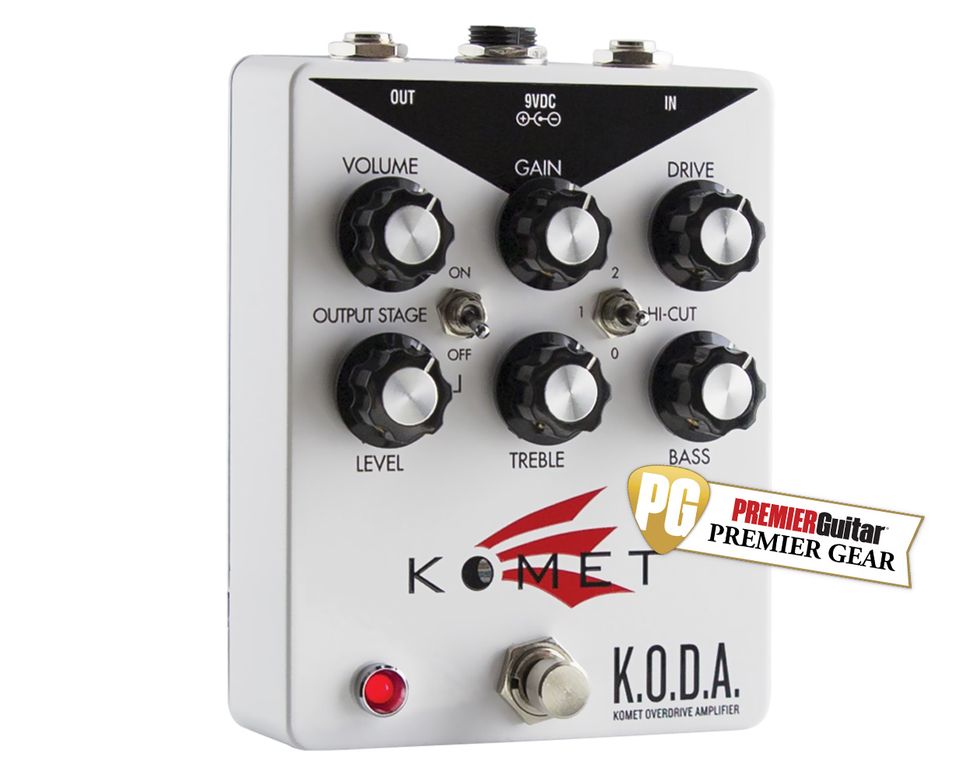RatingsPros:Fine tones. Easy interface. Super useful. Cons: Doesn’t do freaky, over-the-top fuzz. Street: $249 Komet K.O.D.A. kometamps.com | Tones: Ease of Use: Build/Design: Value: |
Baton Rouge, Louisiana-based Komet Amplification is best known for their flagship amplifier model, the Komet 60. Trainwreck mastermind Ken Fischer designed it before his untimely death in 2006. Their debut pedal is the K.O.D.A., short for Komet Overdrive Amplifier.
Thinking Inside the Box
Komet bills the K.O.D.A. as an amp-in-a-box—a description applied to an entire species of stompbox. Like most pedals of that description, it’s more useful in front of an amp than as an amp simulator. (Though you can get good faux-amp sounds using software speaker emulations.)
Most such pedals mimic a particular amp, often by replicating its circuitry with transistors standing in for tubes. The K.O.D.A. is different. It’s not about making your Fender tweed sound like a Marshall plexi, or vice-versa. It’s more of a Swiss Army tone tool whose controls happen to mirror those of a vintage-style amp. It doesn’t do freaky stuff. It always sounds conventionally amp-like. But it can definitely expand an amp’s tonal range.
All Gain, No Pain
Any player who has spent time thinking about gain-staging—that is, how the boost stages in your signal chain interact, and the sonic consequences of boosting in one location rather than another—is likely to understand the K.O.D.A. within minutes.
Here, you have four active gain stages plus active bass and treble tone controls. The drive control is simply a clean input boost, though there’s ample power gain to make a clean amp dirty. Next comes gain, a distortion stage. You can summon a broad spectrum of tones with varying drive/gain mixes. If the K.O.D.A. had only these two knobs, it would be pretty darn useful.
Sculpting With EQ
The K.O.D.A.’s 2-band tone control is gorgeous. Their ranges are relatively narrow. They focus on the frequencies and levels you’re likeliest to need. Again, they don’t produce extreme effects, but there are literally no unusable settings. Treble adds just the right slice. You can further refine its effect with a subtle 3-position bright switch (off, mild treble cut, and a slightly less-mild treble cut).
The bass knob can add nice low-mid mass, but don’t be surprised if you find yourself using it subtractively. Multiple gain stages can accumulate overpowering lows, yielding muddy tones. But with the right bass cut, you can slather on more gain while maintaining definition.
The Sound of Power
The K.O.D.A.’s ace in the hole is its output stage control—a damn good power-amp simulation. When cranked, the knob replicates the low-end thump and smooth compression of a hard-working non-master-volume amp. It makes your amp sound loud, even when it’s not. (You can toggle this stage out of the circuit if desired.)
The K.O.D.A.’s final stage is a simple master volume control. At low settings, you can crank the upstream controls for color without necessarily incinerating your amp. Or you might keep the boost and gain controls low, and use volume for a nice clean boost.
My demo clip online demonstrates a few possible K.O.D.A. scenarios. I recorded a short phrase using only the PAF bridge pickup of a DIY guitar, and then reamped it repeatedly through a small Fender-flavored combo set to a rather wimpy clean tone. You hear the bypassed sound first, followed by a grab bag of possible settings. The amp’s knobs never move.
The K.O.D.A. lives in a standard BB-sized enclosure with Boss-style knobs. There’s room for a battery, or you can use any standard 9V power supply.
The Verdict
If there’s such a thing as a drive pedal for tone snobs, the K.O.D.A. is an example. It’s not radical enough to reconfigure your sound, but it can fatten, sharpen, and refine it. It’s a bit Klon-like in that regard, but with interactive gain stages and a lovely active tone circuit. The pedal would be especially useful perched on a studio desktop, shaping sounds to suit a mix. It was obviously voiced by guitarists with good ears, and those are the players likeliest to appreciate this refined tool.
















![Rig Rundown: Russian Circles’ Mike Sullivan [2025]](https://www.premierguitar.com/media-library/youtube.jpg?id=62303631&width=1245&height=700&quality=70&coordinates=0%2C0%2C0%2C0)

















